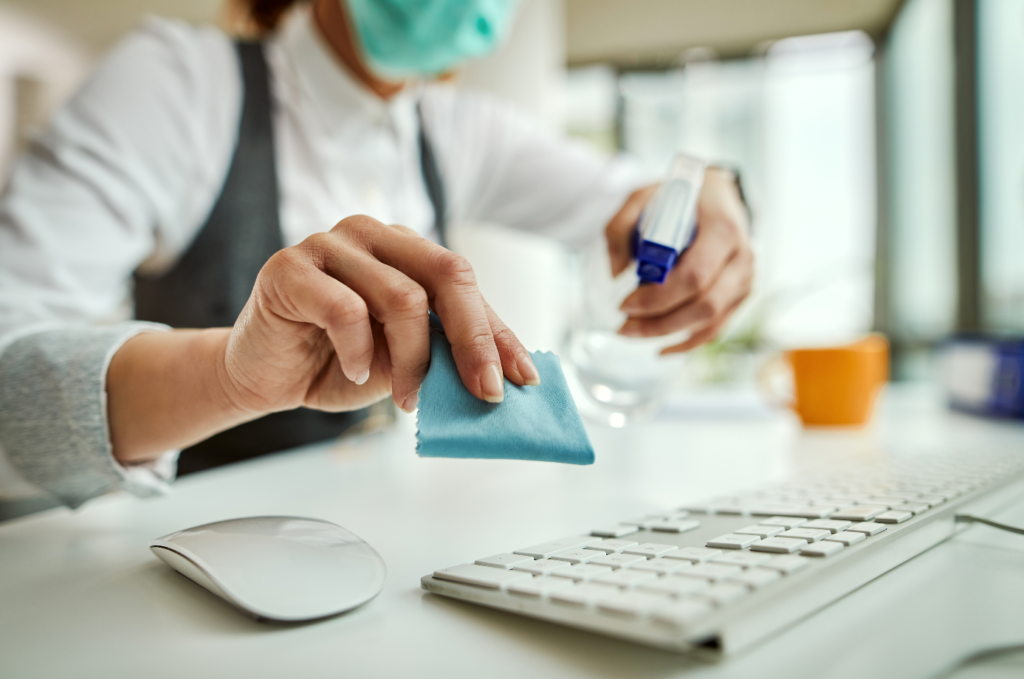Over the past few weeks, we’ve had an influx of clients wanting to resume their office cleaning contracts, as they pull employees from their sofas and back into their suits. For most workplaces, the return to the office will be a lengthy process with ‘office culture’ as we always knew it significantly changing.
So, we wanted to make the back-to-office migration a little easier as there’s a lot to consider. In this blog we’ll highlight all the areas of your typical office which experts have recognised as COVID-19 hotspots (among many other things).
As the government campaigns for people to get back to their old routines; daily commutes, back to school and office, it’s easy to forget the risk that ‘normal’ poses for us all. With it being so easy to fall back into old ways, it’s important first and foremost to regularly remind everyone of the guidelines and rules they should be following. Posters and internal email blasts would be good for this.
Hand sanitiser stations, daily temperature checks and staff rotations will be a familiar part of post-lockdown office life. So, with the general rules covered, where are the more high-risk areas in the office?
There are experts who believe that if just one surface is contaminated in the office, then within just a few hours the whole workplace can be affected.
A chief scientist at PPE company ViraxCare compiled a list of the main ‘COVID Hotspots’ in the office, and outlined the preventative measures you can take to keep yourself safe at work:
Toilet cubicles – don’t forget your mask! Toilet cubicles are already well-known high-risk touch points, however direct contact is not all you need to be wary of. Wearing masks in bathrooms is now just as important; when flushing toilets infectious aerosols containing faecal matter from those infected with COVID-19 can be released. It’s the reason why, even prior to the pandemic, public toilets have lid systems installed as a way of preventing the particles entering the air. Particles can travel up to 1 metre from the toilet when the lid isn’t closed, and this method of transmission is just as infectious as any other. Wear your mask, close the lid and wash your hands thoroughly when you’re finished.
Lift buttons – maybe take the stairs? Pre-pandemic, pressing the lift button might not have been something you thought about, but COVID-19 has brought to attention the hundreds of times in a day they are pressed. In winter months, gloves will be ample enough protection as you enter/exit the workplace etc. Ideally, hands should be sanitised before and after touching any communal buttons; disposable gloves are also a viable option.
Door handles – elbows are the new hands. Like lift buttons, door handles pose the same issues. If you’re lucky enough to work in a modern, open-plan office with automatic doors then it’s much less of an issue, but for the rest of us disposable gloves, hand-sanitiser and the odd use of an elbow can make all the difference.
The coffee machine/kettle – beware of the kitchen. The office kitchen, a place for eating, drinking, hiding and gossiping. It’s also a huge hotspot for viruses to live and spread with so many shared appliances like; taps, kettles, fridges, microwaves. Even if you hire an office cleaner to clean and sanitise after each day, it’s still worth having some disinfectant wipes handy in the kitchen for people to use before/after personal use of appliances. Remember – always wash your hands!
Confined spaces – who likes those anyway?! Unsurprisingly, viruses transmit more easily indoors, particularly in smaller spaces like lifts, office cubicles and staff rooms. The number of people occupying confined spaces at any one time should be limited, and masks should be encouraged whenever possible. Ventilation in such space is also a huge factor in transmission in the workplace. Poor ventilation allows for stagnant air in which viral droplets can linger for hours, but then airflow generated by air conditioning systems can also facilitate the spread of infection. The workaround for this is ensuring that employees are positioned out of direct airflow of heating and aircon systems.
Ultimately, the best way for companies to ensure that the back-to-work process is as safe as possible is to have clear, strict guidelines in place and to be aware of what the biggest risks to staff are. Be responsible for yourself and others around you. We’ve created a printable office poster for you to place around your office/workplace, you can download it here.
If you’re looking for contract cleaners to keep your office cleaning and sanitised on a regular basis, then contact us on 0161 883 0328 – we’ll come and quote your premises for free. You can read about our 8-Point Plan to tackle Coronavirus here.

